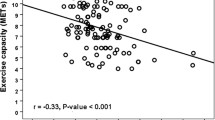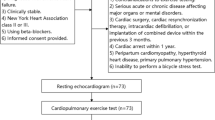Abstract
Left atrium function is essential for cardiovascular performance and is evaluable by two-dimensional speckle-tracking echocardiography (2D-STE). Our aim was to determine how echocardiographic parameters interrelate with exercise capacity and ventilatory efficiency in subjects with no structural heart disease. Asymptomatic volunteers, in sinus rhythm and with normal biventricular size and function, were recruited from a community-based population. Individuals with moderate-to-severe valvular disease, pulmonary hypertension, and history of cardiac disease were excluded. We performed a transthoracic echocardiogram and assessed left atrial (LA) and left ventricular (LV) mechanics via 2D-STE. Cardiopulmonary exercise testing by treadmill took place immediately thereafter. Peak oxygen uptake (VO2) served as measure of functional capacity and ventilation/carbon dioxide output (VE/VCO2) slope as surrogate of ventilation/perfusion mismatch. 20 subjects were included (age 51 ± 14 years, male gender 65%). Peak VO2 strongly correlated with age (r = −0.83; P < 0.01), with E/e′ ratio (r = −0.72; P < 0.01), and with LA reservoir- and conduit-phase mechanics, particularly with LA conduit strain rate (SR) (r = −0.82; P < 0.01), but showed no correlation with LA volume index or LV mechanics. A similar pattern of associations was identified for VE/VCO2 slope. In multivariate analysis, LA conduit SR (β = −0.69; P = 0.02) emerged as sole independent correlate of peak VO2, adjusted for age and for E/e′ ratio (adjusted r 2 = 0.76; P < 0.01). Conduit and reservoir components of LA mechanics displayed strong associations with peak VO2 and VE/VCO2 slope. LA conduit-phase SR seems best suited as echocardiographic marker of functional capacity in subjects with no structural heart disease.


Similar content being viewed by others
Abbreviations
- ACE:
-
Angiotensin converting enzyme
- ARB:
-
Angiotensin II receptor blocker
- BMI:
-
Body mass index
- BSA:
-
Body surface area
- CCB:
-
Calcium channel blockers
- CPET:
-
Cardiopulmonary exercise testing
- GLS:
-
Global longitudinal Ɛ
- HFpEF:
-
Heart failure with preserved ejection fraction
- IPAQ:
-
International physical activity questionnaire
- LA:
-
Left atrium
- LAVI:
-
Left atrium volume index
- LV:
-
Left ventricle
- LVEF:
-
Left ventricle ejection fraction
- MET:
-
Metabolic equivalents
- RER:
-
Respiratory exchange ratio
- RV:
-
Right ventricle
- SR:
-
Strain rate
- VE/VCO2 :
-
Ventilation/carbon dioxide output
- VO2 :
-
Peak oxygen uptake
- Ɛ:
-
Strain
- 2D-STE:
-
Two-dimensional speckle-tracking echocardiography.
References
Brecht A, Oertelt-Prigione S, Seeland U et al. (2016) Left atrial function in preclinical diastolic dysfunction: two-dimensional speckle-tracking echocardiography-derived results from the BEFRI trial. J Am Soc Echocardiogr 29(8):750–758
Lang RM, Badano LP, Mor-Avi V et al (2015) Recommendations for cardiac chamber quantification by echocardiography in adults: an update from the american society of echocardiography and the european association of cardiovascular imaging. J Am Soc Echocardiogr 28(1–39):e14
Morris DA, Takeuchi M, Krisper M et al (2015) Normal values and clinical relevance of left atrial myocardial function analysed by speckle-tracking echocardiography: multicentre study. Eur Heart J Cardiovasc Imaging 16:364–372
Vieira MJ, Teixeira R, Gonçalves L, Gersh BJ (2014) Left atrial mechanics: echocardiographic assessment and clinical implications. J Am Soc Echocardiogr 27:463–478
ERS Task Force, Palange P, Ward SA et al (2007) Recommendations on the use of exercise testing in clinical practice. Eur Respir J 29:185–209
Myers J, Prakash M, Froelicher V et al (2002) Exercise capacity and mortality among men referred for exercise testing. N Engl J Med 346:793–801
Minkkinen M, Nieminen T, Verrier RL et al (2015) Prognostic capacity of a clinically indicated exercise test for cardiovascular mortality is enhanced by combined analysis of exercise capacity, heart rate recovery and T-wave alternans. Eur J Prev Cardiol 22:1162–1170
Malhotra R, Bakken K, D’Elia E, Lewis GD (2016) Cardiopulmonary exercise testing in heart failure. JACC Heart Fail 4:607–616
Dubois D, Dubois E (1916) A formula to estimate the approximate surface area if height and weight are known. Arch Inter Med 17:863–871
Keys A, Fidanza F, Karvonen MJ et al (1972) Indices of relative weight and obesity. J Chronic Dis 25:329–343
Craig CL, Marshall AL, Sjöström M et al (2003) International physical activity questionnaire: 12-country reliability and validity. Med Sci Sports Exerc 35:1381–1395
Evangelista A, Flachskampf F, Lancellotti P et al (2008) European association of echocardiography recommendations for standardization of performance, digital storage and reporting of echocardiographic studies. Eur J Echocardiogr 9:438–448
Cameli M, Caputo M, Mondillo S et al (2009) Feasibility and reference values of left atrial longitudinal strain imaging by two-dimensional speckle tracking. Cardiovasc Ultrasound 7:6
Cameli M, Lisi M, Righini FM, Mondillo S (2012) Novel echocardiographic techniques to assess left atrial size, anatomy and function. Cardiovasc Ultrasound 10:4
Kurt M, Wang J, Torre-Amione G, Nagueh SF (2009) Left atrial function in diastolic heart failure. Circ Cardiovasc Imaging 2:10–15
Mor-Avi V, Lang RM, Badano LP et al (2011) Current and evolving echocardiographic techniques for the quantitative evaluation of cardiac mechanics: ASE/EAE consensus statement on methodology and indications endorsed by the Japanese Society of Echocardiography. Eur J Echocardiogr 12:167–205
American Thoracic Society, American College of Chest Physicians (2003) ATS/ACCP statement on cardiopulmonary exercise testing. Am J Respir Crit Care Med 167:211–277
Donal E, Behagel A, Feneon D (2015) Value of left atrial strain: a highly promising field of investigation. Eur Heart J Cardiovasc Imaging 16:356–357
Santos ABS, Roca GQ, Claggett B et al. (2016) Prognostic relevance of left atrial dysfunction in heart failure with preserved ejection fraction. Circ Hear Fail 9:1–12
Kusunose K, Motoki H, Popovic ZB et al (2012) Independent association of left atrial function with exercise capacity in patients with preserved ejection fraction. Heart 98:1311–1317
Freed BH, Daruwalla V, Cheng JY et al. (2016) Prognostic utility and clinical significance of cardiac mechanics in heart failure with preserved ejection fraction: importance of left atrial strain. Circ Cardiovasc Imaging 9(3):e003754
Kowallick JT, Lotz J, Hasenfuß G, Schuster A (2015) Left atrial physiology and pathophysiology: role of deformation imaging. World J Cardiol 7:299–305
Acknowledgements
The authors thank António Barbosa BSc, and Ana Paula Oliveira BSc, for their help during initial echocardiographic patient evaluations.
Author information
Authors and Affiliations
Corresponding author
Ethics declarations
Conflict of interest
The authors declare that they have no conflict of interest.
Ethical approval
All procedures performed in studies involving human participants were in accordance with the ethical standards of the institutional and/or national research committee and with the 1964 Helsinki declaration and its later amendments or comparable ethical standards.
Informed consent
Informed consent was obtained from all individual participants included in the study.
Rights and permissions
About this article
Cite this article
Leite, L., Mendes, S.L., Baptista, R. et al. Left atrial mechanics strongly predict functional capacity assessed by cardiopulmonary exercise testing in subjects without structural heart disease. Int J Cardiovasc Imaging 33, 635–642 (2017). https://doi.org/10.1007/s10554-016-1045-3
Received:
Accepted:
Published:
Issue Date:
DOI: https://doi.org/10.1007/s10554-016-1045-3




